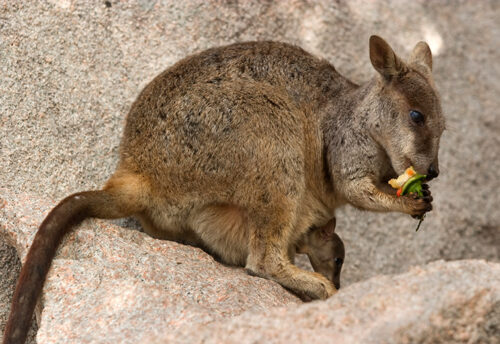
The Rothschild’s rock-wallaby, aka Roebourne rock-wallaby, is a species of wallaby that hails from Australia. They are 1 of the largest rock-wallabies. They face the threats of habitat loss and destruction, and invasive species, in the form of the red fox, which preys on them. However, they are abundant enough to be listed as Least Concern by the IUCN. Their population trend is unknown at this time.
First the Stats…
Scientific name: Petrogale rothschildi
Weight: Up to 7.72 lbs.
Length: Up to 23.62 inches, plus up to a 27.56 inch tail
Lifespan: Up to 15 years
Now on to the Facts!
1.) These critters are nocturnal (active at night).
2.) They were first described by Oldfield Thomas in 1904.
3.) Being very shy and reclusive, these rock-wallabies are challenging to study.
4.) The preferred habitats are hummocks of vegetation covering scree slopes, near boulder piles, and on cliff faces.
5.) Buffel grass, herbaceous plants, fruits of native Ficus species, and prickly pear are all on the menu.
But wait, there’s more on the Rothschild’s rock-wallaby!
6.) Females undergo up to a 32 day gestation (pregnancy) that yields a single joey.
7.) Joeys continue to develop in the marsupium (pouch) for an additional 230 days.
Did you know…?
These rock-wallabies can jump upwards of 13 feet!
8.) With the increased amount of roads, subsequently there have also been an increase in vehicle strikes (being hit by vehicles).
9.) They have been displaced by mining of iron ore in the region, and proposals for future ventures are expected to impact an even larger area of their range.
10.) Obtaining the necessary moisture from the plants they eat, these rock-wallabies can go for months without drinking standing water!
Now a Short Rothschild’s Rock-Wallaby Video!
This video talks about rock-wallabies in general.
Be sure to share & comment below! Also, check out the Critter Science YouTube channel. Videos added regularly!

Want to suggest a critter for me to write about? Let me know here.
Some source material acquired from: Wikipedia & IUCN
Photo credit: iNaturalist




Leave a Reply